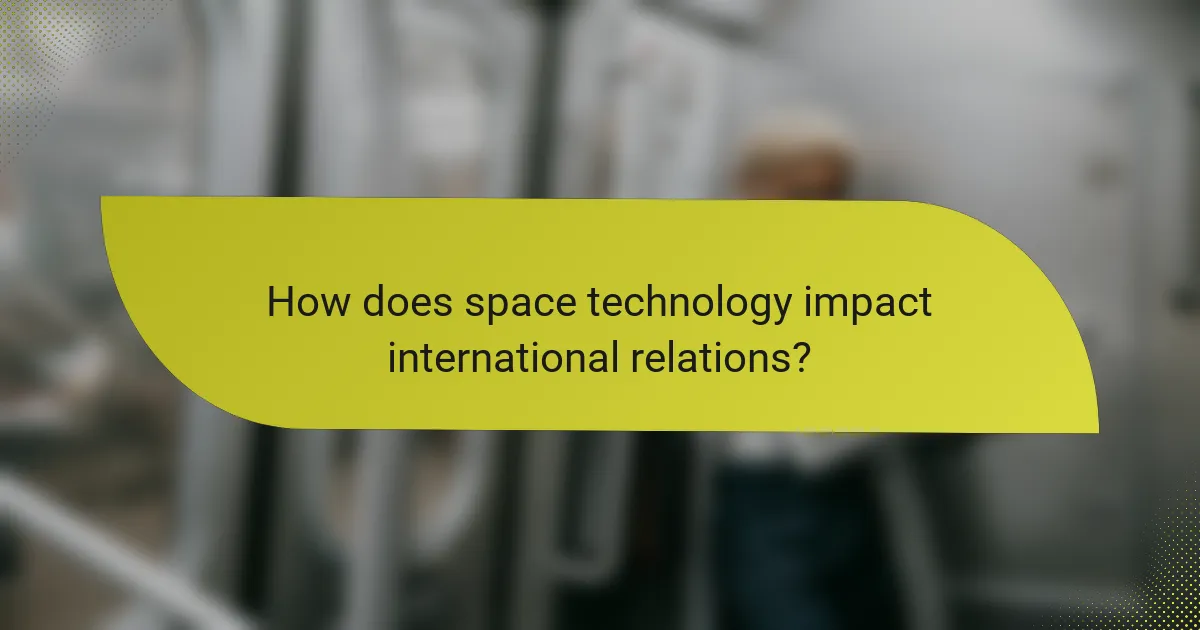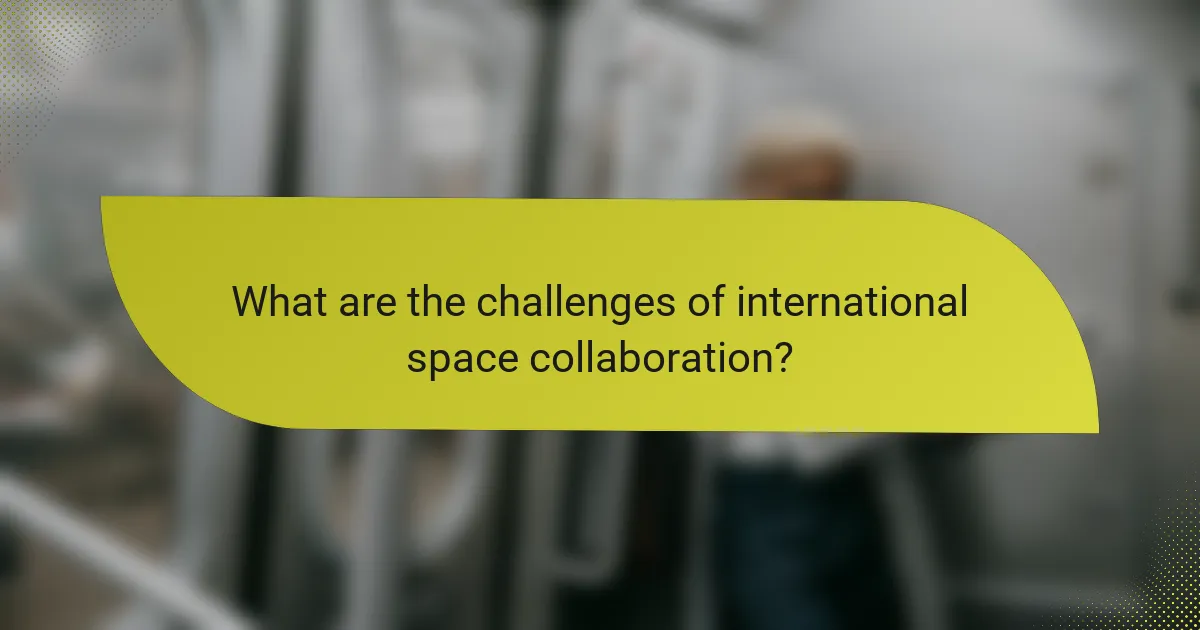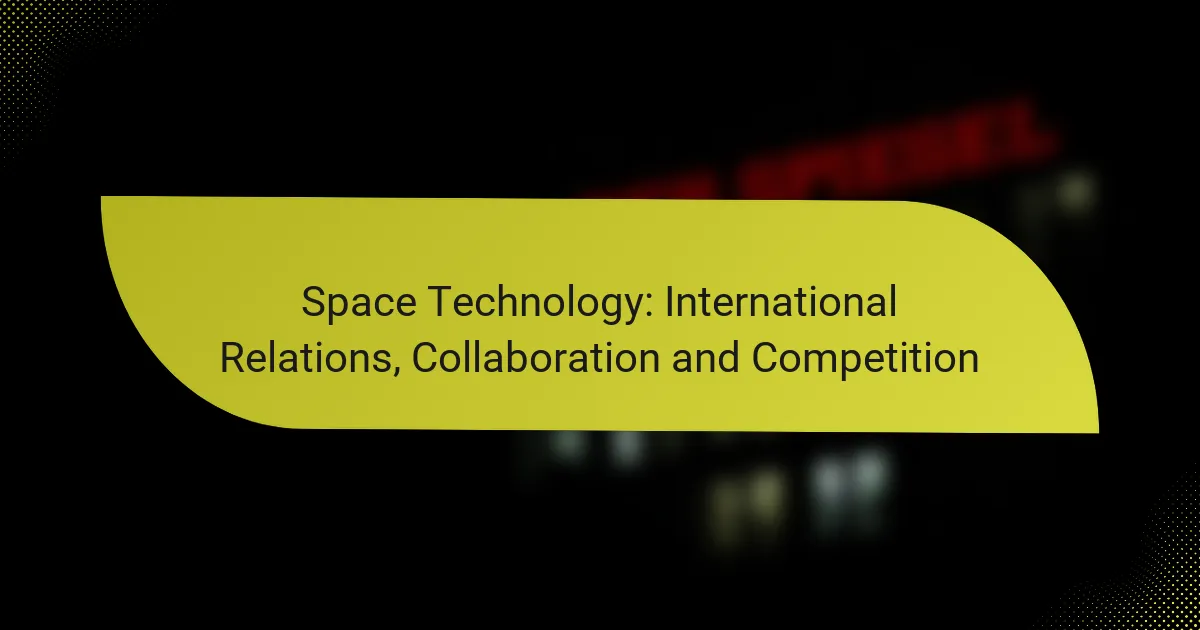Space technology plays a pivotal role in shaping international relations, fostering both collaboration and competition among nations. As countries engage in joint initiatives for space exploration and research, they share resources and knowledge, enhancing global capabilities. Simultaneously, the race for technological superiority drives nations and private entities to compete for strategic advantages in areas such as national security and commercial ventures.

How does space technology impact international relations?
Space technology significantly influences international relations by fostering collaboration among nations while also introducing competitive dynamics. The advancements in satellite communication, space exploration, and defense capabilities shape diplomatic ties and strategic partnerships globally.
Enhances diplomatic collaboration
Space technology serves as a platform for nations to work together on shared goals, such as climate monitoring and disaster response. Collaborative projects like the International Space Station (ISS) exemplify how countries can pool resources and expertise to achieve scientific advancements.
Joint missions and research initiatives often lead to stronger diplomatic relations, as countries recognize the mutual benefits of cooperation. For instance, partnerships in satellite technology can enhance global communication and data sharing, fostering trust and collaboration among nations.
Facilitates conflict resolution
Space technology can play a crucial role in mitigating conflicts by providing transparency and monitoring capabilities. Satellite imagery allows nations to observe military movements and environmental changes, which can help de-escalate tensions and prevent misunderstandings.
Additionally, international agreements on the use of space, such as the Outer Space Treaty, promote peaceful exploration and discourage militarization. These frameworks encourage dialogue and cooperation, reducing the likelihood of conflicts arising from space-related activities.
Influences global power dynamics
The race for dominance in space technology can shift global power dynamics, as nations with advanced capabilities gain strategic advantages. Countries investing heavily in space exploration and satellite systems can enhance their geopolitical influence and economic competitiveness.
For example, nations like the United States and China are engaged in a technological rivalry that extends to space, impacting their international relations. This competition can lead to increased investment in research and development, shaping the future landscape of global power.

What are the key collaborative space initiatives?
Key collaborative space initiatives include international projects that promote cooperation among countries in space exploration and research. These initiatives aim to share resources, knowledge, and technology, enhancing global capabilities in space activities.
International Space Station (ISS)
The International Space Station (ISS) is a prime example of international collaboration in space. Launched in 1998, it involves partnerships among five space agencies: NASA (USA), Roscosmos (Russia), ESA (Europe), JAXA (Japan), and CSA (Canada). The ISS serves as a microgravity research laboratory where scientific research is conducted in astrobiology, astronomy, meteorology, and other fields.
Participating countries contribute funding, technology, and expertise, allowing for shared costs and risks. The ISS has hosted numerous international missions, fostering cooperation and diplomacy among nations, while also advancing scientific knowledge that benefits all humanity.
Artemis Accords
The Artemis Accords are a set of agreements established to promote peaceful and cooperative exploration of the Moon and beyond. Initiated by NASA in 2020, these accords outline principles for sustainable lunar exploration, including transparency, interoperability, and the responsible use of space resources. Countries signing the accords commit to working together on missions to the Moon and Mars.
As of now, over 20 countries have joined the Artemis Accords, which aim to create a framework for international collaboration in space exploration. This initiative encourages nations to share data and technology, ensuring that space exploration is conducted in a safe and responsible manner.
European Space Agency (ESA) partnerships
The European Space Agency (ESA) fosters collaboration among its member states and with other international partners. ESA’s partnerships focus on various areas, including Earth observation, satellite navigation, and space science. By pooling resources and expertise, ESA enhances the capabilities of its member countries in space technology and research.
ESA collaborates with organizations like NASA and the Indian Space Research Organisation (ISRO) on joint missions, such as the Mars Express and the upcoming Lunar Gateway project. These partnerships not only advance scientific objectives but also strengthen diplomatic ties between nations through shared goals in space exploration.

What are the competitive aspects of space technology?
The competitive aspects of space technology involve various nations and private entities striving for superiority in capabilities, resources, and strategic advantages. This competition manifests in national security, commercial ventures, and advancements in satellite systems.
National security concerns
National security is a primary driver of competition in space technology, as countries seek to protect their interests and maintain strategic advantages. Nations invest heavily in military satellite systems for surveillance, reconnaissance, and communication, which are crucial for defense operations.
For instance, the United States and China have significantly ramped up their satellite capabilities to monitor each other’s activities. This has led to a race not only in developing advanced technologies but also in establishing legal frameworks to govern space operations and prevent conflicts.
Commercial space race
The commercial space race has intensified with the emergence of private companies like SpaceX, Blue Origin, and Virgin Galactic. These firms are competing to provide launch services, satellite deployment, and even space tourism, driving innovation and reducing costs.
Investment in the commercial sector is substantial, with billions of dollars flowing into startups and established companies alike. This competition fosters rapid advancements in technology, such as reusable rockets, which can lower launch costs by significant margins, often by tens of percent.
Technological advancements in satellite systems
Technological advancements in satellite systems are at the forefront of the competitive landscape in space technology. Innovations such as miniaturization, improved propulsion systems, and enhanced communication capabilities are transforming satellite design and functionality.
Countries and companies are increasingly deploying small satellites, or CubeSats, which are cost-effective and can be launched in groups, allowing for more extensive coverage and data collection. This shift not only enhances capabilities but also democratizes access to space technology, enabling smaller nations and organizations to participate in the space race.

How do countries collaborate in space exploration?
Countries collaborate in space exploration through various formal agreements and joint initiatives aimed at sharing resources, knowledge, and technology. This cooperation enhances scientific research and reduces costs while promoting peaceful uses of outer space.
Bilateral agreements
Bilateral agreements are arrangements between two countries that outline specific terms for cooperation in space activities. These agreements can cover a range of topics, including satellite launches, data sharing, and joint research initiatives. For example, the United States and Japan have established agreements to collaborate on satellite technology and space exploration missions.
Such agreements often include provisions for intellectual property rights and funding responsibilities, ensuring both parties benefit from the collaboration. Countries should carefully negotiate terms to avoid misunderstandings and ensure mutual interests are met.
Multilateral treaties
Multilateral treaties involve three or more countries and are designed to establish common frameworks for space exploration and usage. The Outer Space Treaty of 1967 is a foundational multilateral agreement that outlines principles for the peaceful use of outer space, including the prohibition of nuclear weapons in space and the requirement for countries to avoid harmful interference with each other’s activities.
These treaties often require extensive negotiation and consensus-building, making them complex but essential for fostering international cooperation. Countries should engage in ongoing dialogue to adapt these treaties to new challenges, such as space debris management and the commercialization of space activities.
Joint missions and research projects
Joint missions and research projects allow countries to pool resources and expertise for specific space exploration goals. Collaborative efforts, such as the International Space Station (ISS), demonstrate how nations can work together to conduct scientific research in a shared environment. The ISS involves multiple countries, including the United States, Russia, and members of the European Space Agency, contributing to its operation and research initiatives.
Countries should consider the logistical and financial implications of joint missions, including shared responsibilities for funding and technology development. Successful collaboration often hinges on clear communication and defined roles to ensure that all partners are aligned in their objectives and contributions.

What are the challenges of international space collaboration?
International space collaboration faces several challenges that can hinder effective partnerships. Key issues include regulatory hurdles, disputes over resource allocation, and technological disparities among nations.
Regulatory hurdles
Regulatory hurdles often complicate international space collaboration by creating a patchwork of laws and guidelines that vary by country. Each nation has its own space policies, which can lead to conflicts and misunderstandings regarding responsibilities and liabilities.
For example, the Outer Space Treaty outlines basic principles for space activities, but individual countries may have additional regulations that affect collaboration. Navigating these regulations requires thorough understanding and careful negotiation to ensure compliance and mutual benefit.
Resource allocation disputes
Disputes over resource allocation can arise when countries collaborate on space missions, particularly regarding funding and access to shared technologies. Nations may have different priorities and expectations, leading to tensions over who receives what resources and when.
To mitigate these disputes, clear agreements should be established at the outset, detailing contributions and benefits for all parties involved. Regular communication and transparency can help maintain trust and facilitate smoother collaboration.
Technological disparities
Technological disparities among countries can create significant barriers to effective collaboration in space. Nations with advanced space programs may have access to cutting-edge technologies, while others may rely on outdated systems, leading to imbalances in contributions and capabilities.
Addressing these disparities requires targeted investment in technology transfer and capacity building for less developed nations. Joint training programs and shared research initiatives can help bridge the gap and foster a more equitable partnership in space exploration.

What role do private companies play in space technology?
Private companies are increasingly pivotal in space technology, driving innovation and expanding access to space through commercial ventures. They collaborate with governments and other entities, enhancing capabilities in satellite deployment, exploration, and research.
Commercial partnerships with governments
Commercial partnerships between private companies and governments are essential for advancing space technology. These collaborations often involve contracts for satellite launches, research funding, and technology development, allowing governments to leverage private sector efficiency and innovation.
For example, NASA’s Commercial Crew Program has enabled companies like SpaceX and Boeing to develop spacecraft for transporting astronauts to the International Space Station. Such partnerships can reduce costs and accelerate project timelines, benefiting both parties.
Innovation in satellite technology
Private companies are at the forefront of innovation in satellite technology, developing smaller, more efficient satellites that can be deployed at lower costs. This trend has led to the rise of mega-constellations, where thousands of small satellites work together to provide global internet coverage.
Companies like OneWeb and Starlink are examples of this innovation, aiming to deliver high-speed internet to underserved areas. As satellite technology advances, the potential for applications in telecommunications, Earth observation, and scientific research continues to expand, creating new markets and opportunities.
